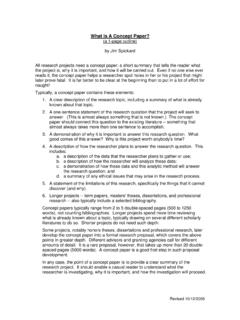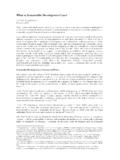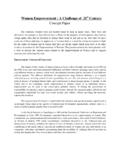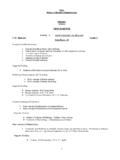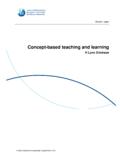Transcription of Concept paper on the development of product …
1 25 July 2013. EMA/CHMP/423137/2013. Committee for Medicinal Products for Human Use (CHMP). Concept paper on the development of product - specific guidance on demonstration of bioequivalence Agreed by Pharmacokinetics Working Party July 2013. Adoption by CHMP for release for consultation 25 July 2013. Start of public consultation 01 August 2013. End of consultation (deadline for comments) 30 September 2013. Comments should be provided using this template. The completed comments form should be sent to Keywords Bioequivalence, generics 7 Westferry Circus Canary Wharf London E14 4HB United Kingdom Telephone +44 (0)20 7418 8400 Facsimile +44 (0)20 7418 8416.
2 E-mail Website An agency of the European Union European Medicines Agency, 2013. Reproduction is authorised provided the source is acknowledged. 1. Introduction The general European Union requirements for bioequivalence demonstration are laid out in the Guideline on Investigation of Bioequivalence (CPMP/EWP/QWP/1401/98 Rev. 1). In addition, the Pharmacokinetics Working Party (PKWP) started in 2009 to publish positions addressing specific questions in relation to the requirements and assessment of bioequivalence studies (EMA/618604/2008).
3 This document describes for specific products the regulatory view on specific aspects related to the demonstration of bioequivalence based on previous assessments of generic medicines. 2. Problem statement To further develop the regulatory framework for demonstration of bioequivalence, it is considered valuable to develop product - specific guidance based on the general principles. This should facilitate transparent, predictable and scientifically robust assessment in future marketing authorisation procedures.
4 3. Discussion (on the problem statement). As stated in the PKWP work plan, the PKWP explored providing scientific support for the identification of substance characteristics important for the assessment of generic products through peer review of respective summary documents. This effort has now led to the Concept of developing product - specific guidance on the bioequivalence demonstration. The aim of developing such guidance is to enable a consistent approach to the assessment of applications based on bioequivalence data, particularly generic applications, across all submission routes, submitted centrally, via the decentralised procedure or mutually recognition procedure, or purely nationally.
5 For companies such product - specific guidance will facilitate the design of study programmes that meet the expectations of European Union regulators hence allowing for better predictability in terms of the assessment during the authorisation process. 4. Recommendation The Pharmacokinetic Working Party recommends drafting product - specific guidance on the demonstration of bioequivalence. It is planned that such guidance is first developed for immediate release formulations for oral use. The guidance is based on the general principles set out in the applicable overarching Guideline on the Investigation of Bioequivalence, and summarises in a standardised format the relevant design principles for bioequivalence demonstration.
6 The following items should be addressed in the guidance : Classification according to the Biopharmaceutical Classification Scheme (BCS) if a BCS. biowaiver seems possible. Design elements of a bioequivalence study, administration schedule, study participants, conditions for administration (fasting/fed), strength to be investigated, and number of studies. Analyte for the bioequivalence demonstration, parent/metabolite, compartment (plasma/blood/urine), and need for an enantioselective method. Criteria for bioequivalence assessment, main pharmacokinetic variables and width of confidence intervals.
7 Concept paper on the development of product - specific guidance on demonstration of bioequivalence EMA/CHMP/423137/2013 Page 2/3. If required, a brief scientific rationale for the guidance will be provided. 5. Proposed timetable The first set of product - specific guidance is planned to be adopted at the CHMP meeting in October 2013 for release for public consultation. 6. Resource requirements for preparation The development of product - specific guidance is led by the PKWP. It requires the input from the assessment team of the originator product (Rapporteur in the centralised procedure; Reference Member State in the DCP/MRP).
8 If necessary, other therapeutic working parties are being consulted to provide particular clinical input, regarding the identification of narrow therapeutic index drugs. 7. Impact assessment (anticipated). The availability of product - specific guidance on the demonstration of bioequivalence will facilitate a transparent, predictable and scientifically robust framework for demonstration of bioequivalence in the interests of all stakeholders. 8. Interested parties Academia, EUFEPS, and pharmaceutical industry, EFPIA and EGA.
9 9. References to literature, guidelines, etc. Guideline on Investigation of Bioequivalence (CPMP/EWP/QWP/1401/98 ). Concept paper on the development of product - specific guidance on demonstration of bioequivalence EMA/CHMP/423137/2013 Page 3/3.










